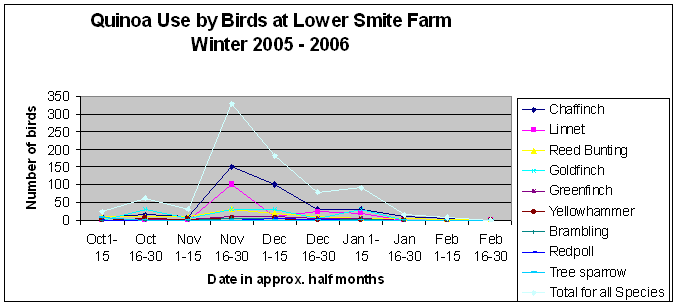
Worcestershire Record No. 20 April 2007 p. 33
Steve Bloomfield
Having entered Countryside Stewardship in late 2004 the Worcestershire Wildlife Trust began a programme of works designed to benefit birds at Lower Smite Farm. Central to this was the establishment of ‘bird cover strips’ in spring of 2005. Primarily designed to provide over-winter food for seed-eating finches and buntings (targets for action under the Countryside Stewardship Scheme) the strips were planted in 20m margins, each approximately 100m long, adjacent to set-aside in two fields on the farm. Both were dominated by Quinoa (a South American food crop) undersown with a mixture of cereals and kale.
The margins established quickly, though there was noticeable variation in quality both within and between the two areas. This appeared to significantly affect later crop use by wintering birds. Indeed the denser of the two strips was the only one to attract large numbers of birds at any time. The reasons for this are not entirely clear although lower seed production and a more ‘open’ nature perhaps contributed to the limited success of the poorer strip.
The denser crop proved to be a significant success. Reed buntings were present from the 5th of September and built to a peak of c30 birds on November the 29th. A daily flock of 10+ then remained throughout the winter with odd birds still foraging through the crop into March. The presence of several ringed individuals suggested a daily movement from nearby Oakley Pool, where ringing is known to take place. Additional support for this theory was provided by pronounced early morning arrivals (from that direction) and late evening departures, often involving small flocks of birds. The expected finches arrived a little later and numbers of chaffinches hovered between 20 and 50 from the 14th of October to the 29th of January with an exceptional peak of 150+ following snow on the 29th of November. Up to five bramblings, seven tree sparrows and four redpolls also put in appearances between late November and mid January. Yellowhammers were conspicuous by their absence for most of the winter though a party of five were recorded several times in November. Linnets peaked at 100+ on the snowy 29th of November pushing the day total for all species using the 20m by 100m strip to 350+ birds! (Mid winter day totals were more usually c80-100). Otherwise it was apparent that the linnets preferred a nearby crop designed primarily to provide a pollen and nectar mix for invertebrates. Numbers of birds using the quinoa dropped markedly through January, presumably in response to the limited remaining food, and the strips appeared to be devoid of feeding finches and buntings by the end of the first week of March.
That the bird-cover crops provided food for such good numbers of birds throughout the winter was no surprise (though obviously welcome). Something that did provide additional interest was the level of migrant activity associated with the Quinoa earlier in the autumn. The tall, dense structure of the crop, together with its evidently high invertebrate burden provided ideal feeding opportunities for a number of species throughout September and early October. Willow warbler, chiffchaff and whitethroat were all recorded regularly and appeared to be feeding on small inverts within the lower parts of the crop whilst meadow pipits took food from between the seed heads. Up to three whinchats were present between the 5th and 29th of September, apparently feeding on larger invertebrates taken both in flight and from the Quinoa seed-heads, whilst up to four stonechats were present and feeding in the same manner from the 19th to 23rd of September. Another was apparently resident in the crop between 17th and 20th of October, again feeding on invertebrates from the tops of the plants.
| DATE IN HALF APPROXIMATE MONTHS | ||||||||||
| SPECIES | Oct1-15 | Oct 16-30 | Nov 1-15 | Nov 16-30 | Dec 1-15 | Dec 16-30 | Jan 1-15 | Jan 16-30 | Feb 1-15 | Feb 16-30 |
| Chaffinch | 6 | 15 | 10 | 150 | 100 | 30 | 30 | 10 | 5 | 0 |
| Linnet | 0 | 0 | 0 | 100 | 10 | 25 | 20 | 0 | 0 | 0 |
| Reed Bunting | 10 | 10 | 10 | 30 | 20 | 10 | 5 | 5 | 2 | 0 |
| Goldfinch | 0 | 30 | 5 | 30 | 30 | 5 | 30 | 0 | 0 | 0 |
| Greenfinch | 0 | 2 | 2 | 10 | 10 | 5 | 4 | 0 | 0 | 0 |
| Yellowhammer | 0 | 5 | 2 | 5 | 4 | 0 | 0 | 0 | 0 | 0 |
| Brambling | 0 | 0 | 1 | 4 | 4 | 3 | 2 | 0 | 0 | 0 |
| Redpoll | 0 | 0 | 0 | 0 | 4 | 2 | 0 | 0 | 0 | 0 |
| Tree sparrow | 7 | 0 | 0 | 0 | 0 | 0 | 0 | 0 | 0 | 0 |
| Total for all Species | 23 | 62 | 30 | 329 | 182 | 80 | 91 | 15 | 7 | 0 |

The table shows the numbers of birds recorded during 15 day periods throughout the sinter 2005-2006. The chart shows the same data graphically.
| WBRC Home | Worcs Record Listing by Issue | Worcs Record Listing by Subject |